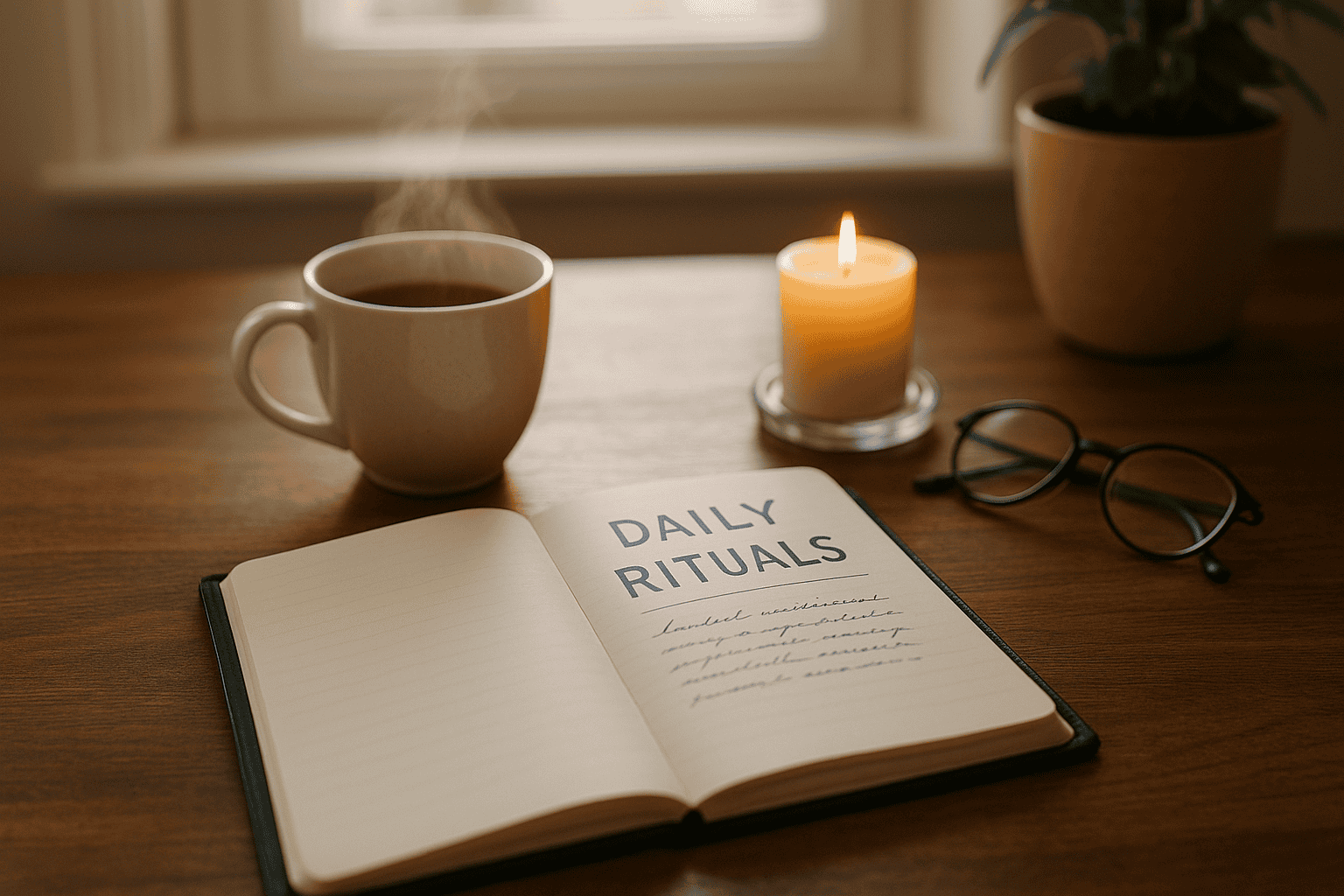5 Powerful Writing Rituals To Fuel Your Creativity
“Discipline is the bridge between goals and accomplishment.” — Jim Rohn
Some writers wait for inspiration to strike. Others train inspiration to meet them at their desk. What separates aspiring writers from published authors isn’t only discipline. It’s rhythm. One of the most effective ways to establish that rhythm is through writing rituals, which empower you to take control of your creative process.
Writing rituals are more than routines. They’re intentional, repeatable cues that tell your brain: It’s time to write. They don’t have to be complicated or mystical. They have to be consistent. Over time, they shape not only your productivity but your mindset, turning scattered effort into sustainable progress and inspiring you to keep going.
This writer’s guide provides five powerful writing rituals you can build into your day to reduce resistance and make your creativity feel inevitable.
1. Begin with a Cue You Enjoy
The best writing rituals begin before the writing starts. Whether it’s brewing a specific type of tea, lighting a candle, or opening a particular playlist, sensory cues can condition your brain to switch into focus mode. When repeated regularly, these small actions become mental triggers, anchoring you in the present and signaling your creative self to take the lead.
The key is to choose a cue that feels personal and pleasurable, not forced. You’re building a bridge between your daily life and your writing life. Make it one you look forward to crossing, one that resonates with you and keeps you engaged in your writing journey.
2. Touch the Page Every Day (Even Briefly)
One of the most underrated writing rituals is simply showing up. Even on low-energy days, even if you only reread yesterday’s work or jot down a sentence or two, you’re keeping the momentum alive.
You don’t have to write thousands of words daily to build consistency. But by opening your project each day, whether you write for 2 minutes or 20, you signal to yourself that this work matters. Over time, this becomes a cornerstone ritual: I don’t skip days. I stay connected to my work.
3. Create a Transition Ritual
Life is noisy, fragmented, and full of distractions. That’s why a short transition ritual is so powerful. It might be a five-minute stretch, a walk around the block, or a journaling prompt like: ‘What do I want to say today?’ This moment of intentional reset separates the reactive world (email, errands, deadlines) from the generative one (your creative voice). It’s simple yet effective.
Transition rituals calm the nervous system and center your thoughts, which is essential if you’re trying to switch gears from a busy day into writing mode.
4. End with a Creative Hook
Don’t wait until you’re exhausted to stop writing. Instead, finish with a “soft landing,” one that leaves a thread for tomorrow.
Ernest Hemingway famously ended his sessions mid-sentence so he could pick up the thread easily the next day. You might leave a comment in your draft like: [Describe the confrontation scene] or write a question to yourself about what’s coming next. Ending with intention gives your subconscious something to work on between sessions and makes it easier to begin again.
5. Reflect, Don’t Judge
After a writing session, many new authors immediately evaluate: Was it good? Did I write enough? Is this publishable? A more productive ritual is to pause and reflect instead. Ask:
- What went well?
- What felt hard today?
- What helped me stay focused?
By turning judgment into curiosity, you’ll cultivate self-awareness and foster a more compassionate, creative process.
Quick Win: Build a Writing Ritual You Can Repeat
Here’s a 5-minute ritual to try right now:
- Brew your favorite beverage
- Open your current draft or writing notebook
- Set a 10-minute timer
- Write one sentence only. No pressure to continue
- Close the draft and jot one reflection: How did that feel?
Repeat this for 3 days. You’ll be amazed how quickly resistance fades.
Wrap-Up: Writing Rituals Make Writing Feel Inevitable
Writing rituals aren’t about superstition. They’re about strategy. When you create reliable cues, smooth transitions, and meaningful endings, you don’t have to wrestle yourself to the chair each day—you want to be there. The right rituals don’t restrict your creativity. They give it a place to land. Writing rituals can remove friction. They make the process more natural and less forced.
Writing doesn’t have to feel like a battle. With the right rituals, it becomes a rhythm. Try one of these today, and let your creativity meet you at the desk.
Explore more strategies in our Writing Focus & Habits series on our website. Print the Writing Rituals Checklist (below) to start building your routine today.
We hope you found these writer’s guide strategies helpful and inspiring. They’re intended to provide you with the necessary tools and insights to succeed as an indie author.
For more guidance on Focus and Habits, see other parts of this series. We suggest starting with Boosting Mental Focus—5 Hacks for New Indie Authors. You might also like AI Empowers New Indie Authors: 5 Best Hacks.
If you have a draft and want to explore how AI can help you self-publish it, read, Is Your Book Ready to Self-Publish? Lastly, for help writing a non-fiction book, read Write Your First Non-Fiction eBook: a 30-Day Workbook for Getting It Done.
Writing is an ongoing adventure that involves continuous learning and improvement. You don’t have to go through this alone. We are excited to accompany you every step of the way, providing you with the support and motivation you need. Our goal is to give you the necessary knowledge and practical advice to navigate the world of writing with confidence.
Don’t wait. Start today! How can we help? To let us know, please fill out our Contact form. Happy writing!
Action Steps
- Choose one sensory cue to start every writing session this week
- Try a short transition ritual to shift into writing mode
- End today’s session with a note to tomorrow’s self
- Reflect for 1 minute after each session: What helped me today?
Writing Rituals That Work—Quick Checklist
Use these five rituals to build consistency, reduce resistance, and make your writing sessions more creative and focused.
Begin with a Sensory Cue
☐ Choose one enjoyable trigger (tea, candle, music, scent)
☐ Use the same cue before each writing session
☐ Notice how your focus improves when the cue is repeated
Touch the Page Every Day
☐ Open your draft, even if just for 2 minutes
☐ Reread a paragraph or write one new sentence
☐ Celebrate the habit of showing up, not the word count
Create a Transition Ritual
☐ Use a brief activity to separate your writing time from daily noise
☐ Try a 5-minute walk, deep breath, or journaling prompt
☐ Notice how the transition time settles your thoughts
End with a Creative Hook
☐ Stop mid-sentence or write a comment to your future self
☐ Leave a scene unfinished to make tomorrow’s session easier
☐ Let your subconscious chew on the next idea overnight
Reflect Without Judgment
☐ After each session, ask: What worked? What felt hard?
☐ Keep a log of daily reflections or short wins
☐ Use self-awareness to adjust your rituals over time
Bonus: Try the 5-Minute Ritual Challenge
☐ Brew a beverage
☐ Set a 10-minute timer
☐ Write one sentence
☐ Reflect on how it felt
☐ Repeat 3 days in a row
#

